Are you tired of having your outdoor furniture stolen? Do you want to keep your belongings safe and secure while still being able to enjoy the great outdoors? Securing outdoor furniture from theft is crucial for homeowners and business owners alike who wish to maintain the integrity and aesthetic of their outdoor living spaces.
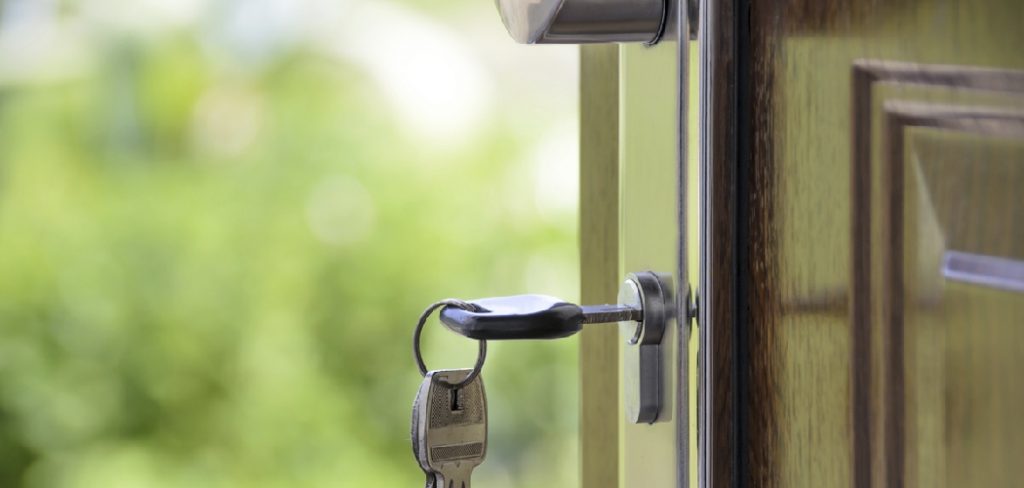
Whether your setup includes luxurious patio sets, unique garden statues, or functional items like outdoor heaters and umbrellas, the investment in these pieces makes them attractive targets for theft. Unfortunately, the rising popularity of outdoor living areas has paralleled an increase in the theft of unsecured outdoor furniture and accessories.
This guide aims to provide practical and effective strategies on how to secure outdoor furniture from theft, ensuring they remain where they belongs and continue to enhance your outdoor environment. Let’s get started!
What are the Benefits of Securing Outdoor Furniture?
Aside from the obvious benefit of preventing theft, there are many other advantages to securing your outdoor furniture. These include:
- Protection of Your Investment: As mentioned before, outdoor furniture can be quite expensive. Properly securing it will ensure that you don’t have to continuously replace stolen items.
- Peace of Mind: Knowing your belongings are safe and secure will allow you to relax and enjoy your outdoor space fully.
- Maintaining the Aesthetics of Your Outdoor Area: Unsecured furniture can easily be moved or damaged, ruining the overall look of your outdoor living space.
- Preventing Potential Injuries: In some cases, unsecured furniture can cause harm or injury to individuals who may accidentally come into contact with it. Securing your furniture will eliminate this risk.
Now that you understand the benefits of securing your outdoor furniture, let’s examine some practical tips on how to do so effectively.
What Will You Need?
Before delving into the various methods of securing outdoor furniture, gathering the necessary tools and materials for the job is important. These may include:
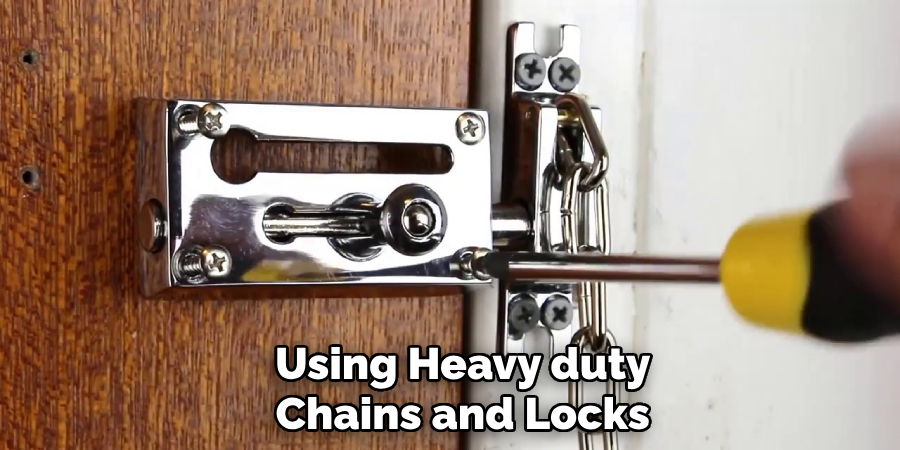
- Heavy-duty chains and locks
- Ground anchors or concrete bolts
- Security cameras
- Motion sensor lights
- Furniture covers
It’s also essential to consider the type of furniture being secured and its location, as these factors will determine the most effective security measures.
10 Easy Steps on How to Secure Outdoor Furniture From Theft:
Step 1. Use Heavy-Duty Chains and Locks:
One of the most straightforward methods to secure outdoor furniture is to use heavy-duty chains and locks. Wrap the chains through the furniture pieces’ frames and secure them with locks, preferably weather-resistant ones, to avoid rust and degradation.
This method is especially effective for furniture with parts that can be easily linked together, such as chairs and tables.
Step 2. Anchor to the Ground:
Consider anchoring them directly to the ground for items that cannot be secured using chains and locks. This can be achieved through the use of ground anchors or concrete bolts for heavier pieces. By firmly securing the legs or base of your furniture to the deck, patio, or garden ground, you significantly lessen the chances of them being moved or stolen.
This approach is particularly useful for larger items like picnic tables or garden statues that may need help to be chained. Ensure that the anchors or bolts you choose are durable and designed for outdoor use to withstand weather conditions.
Step 3. Install Security Cameras:
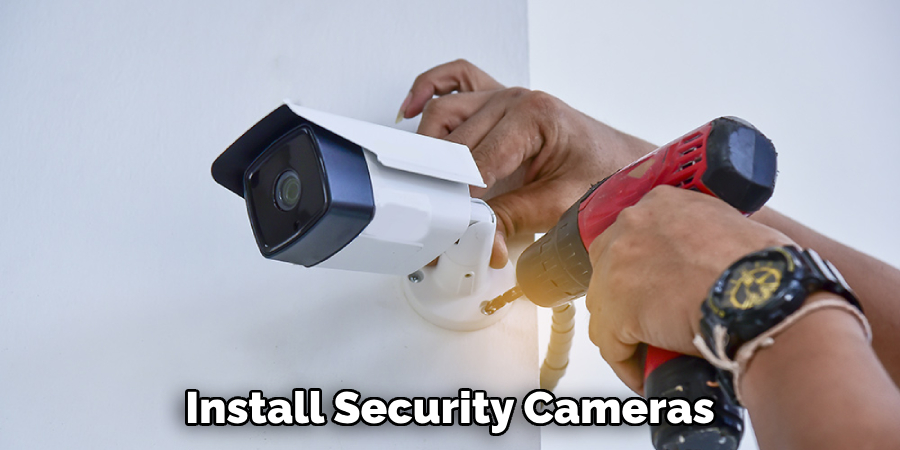
Another effective measure to deter thieves and secure your outdoor furniture is the installation of security cameras. These cameras can be a strong deterrent to potential thieves, as they know their actions might be recorded. Position cameras to cover all angles of your outdoor living space, ensuring there are no blind spots.
Opt for weatherproof and night-vision capable cameras to guarantee round-the-clock surveillance. In addition to deterring theft, these cameras can also help you remotely monitor your outdoor area, providing peace of mind whether at home or away.
Step 4. Utilize Motion Sensor Lights:
Incorporating motion sensor lights around your outdoor living space can serve as a significant deterrent to thieves. The sudden illumination of these lights, when motion is detected, can startle potential intruders, making them think twice about attempting to steal your outdoor furniture.
Position these lights strategically around areas where your furniture is located, especially in darker corners or pathways leading to your outdoor area. Besides enhancing security, motion sensor lights also improve the safety and visibility of your space during nighttime, making it more enjoyable and accessible.
Step 5. Use Furniture Covers with Locks:
A simple yet effective method to secure lighter outdoor furniture pieces is by using furniture covers equipped with locks. These covers not only protect your furniture from the elements but also add an additional layer of security. By locking the covers around your furniture, you make it more difficult for thieves to quickly grab and go.
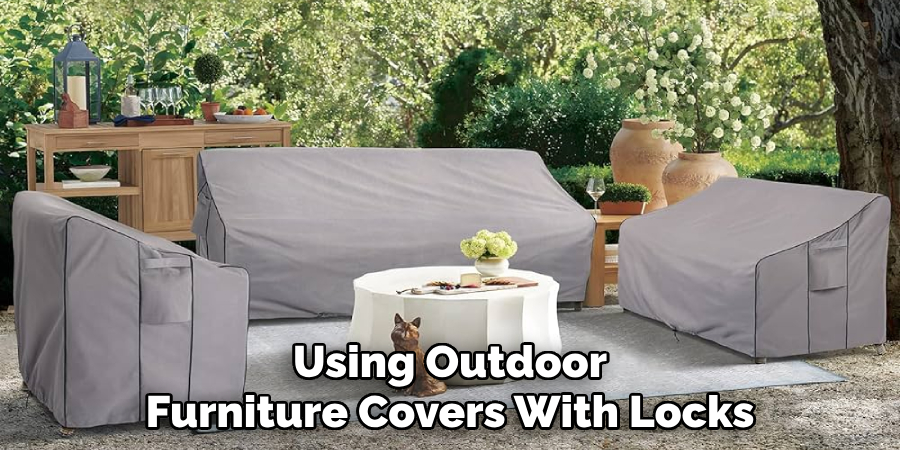
This method is particularly useful for seasonal or less frequently used items, as it also keeps them clean and ready for use. Ensure the covers are made of durable, weatherproof material and that the locks are rust-resistant to withstand outdoor conditions.
Step 6. Secure Loose Accessories:
Many outdoor living spaces include accessories such as cushions, throws, and decorative items that add comfort and style but can easily be overlooked when securing outdoor furniture. To prevent these items from being stolen, consider storing them in a locked storage box or chest when not in use.
For items that are used daily, such as patio cushions, secure them to the furniture with cable ties or specially designed clips that can easily be removed when needed but will deter opportunistic theft. This step ensures that all aspects of your outdoor living space are protected, not just the larger, more obvious pieces.
Step 7. Create a Perimeter Alarm System:
Incorporating a perimeter alarm system can elevate the security of your outdoor living area to the next level. This type of system activates an alarm when someone enters a designated boundary around your property, such as a fence line or the edge of a patio. These alarms can be standalone systems or integrated with your home’s security network for enhanced protection.
When installing a perimeter alarm, make sure it is placed so that it activates before an intruder can reach your outdoor furniture. This proactive approach not only discourages potential thieves but also alerts you and potentially your security provider to an unauthorized entry, allowing for a timely response.
Step 8. Form a Neighborhood Watch Group:
Creating or joining a neighborhood watch group can greatly enhance the security of your outdoor furniture and overall property. Such community-based efforts foster a heightened sense of awareness and collective responsibility for watching over each other’s homes and belongings.
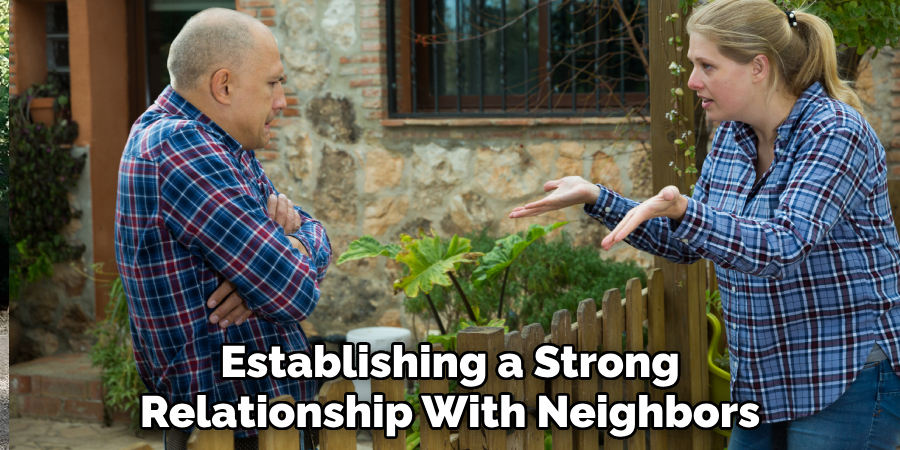
Regular meetings can be held to discuss and implement best practices for local security, including the safeguarding of outdoor areas. Additionally, visible signs indicating participation in a neighborhood watch program can deter potential thieves, as they’re aware that the community is actively looking out for suspicious activities.
Establishing a strong, cooperative relationship with your neighbors creates an additional layer of surveillance and support, making it more difficult for thefts to occur unnoticed.
Step 9. Opt for Smart Locks and Alarms:
Integrating smart locks and alarm systems specifically designed for outdoor use can provide a modern and highly effective security layer for your outdoor furniture. Smart locks can be utilized to secure storage boxes, sheds, or even individual pieces of furniture, offering remote locking and unlocking capabilities through a smartphone app.
Smart alarms, on the other hand, can be attached to furniture or placed strategically around the outdoor area. These devices can notify you immediately via your phone if they detect movement or an attempted breach.
The advantage of using smart technologies lies in their adaptability and the ability to monitor your outdoor space in real time, giving you control and peace of mind no matter where you are.
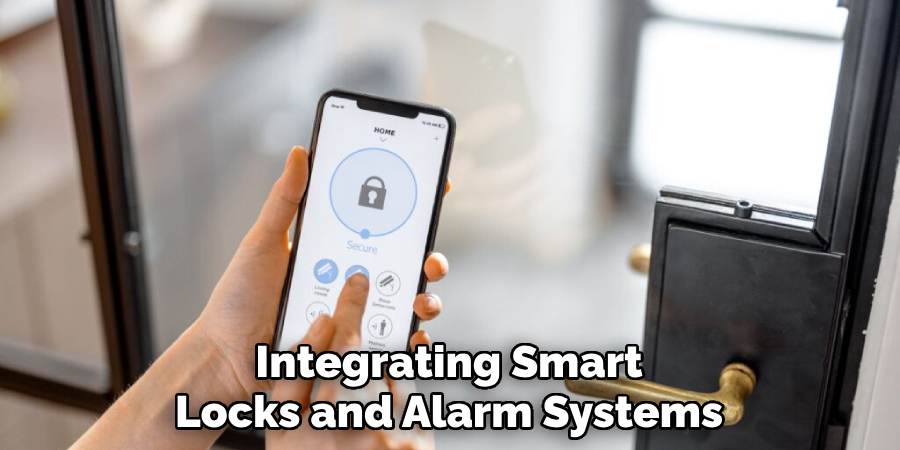
Step 10. Consider Insurance Coverage for Outdoor Furniture:
To further protect your investment in outdoor living spaces, consider obtaining insurance coverage for your outdoor furniture. This may be accomplished through an extension of your home insurance policy or a separate policy specifically for high-value outdoor items.
Insurance can offer financial protection against theft, vandalism, and damage, providing a safety net that ensures you can replace or repair your furniture without significant out-of-pocket expenses. When selecting insurance coverage, ensure it adequately reflects the value and nature of your outdoor furniture and accessories. Additionally, keep an up-to-date inventory of your outdoor items, including photos and receipts, to simplify the claim process if needed. By following these ten steps, you can significantly reduce the risk of outdoor furniture theft and protect your investment in creating a functional and enjoyable outdoor living space.
5 Additional Tips and Tricks
- Use Ground Anchors and Cables: Fastening your outdoor furniture to ground anchors with cables or chains can make it significantly harder for someone to steal your items. Ensure the cables are made of weather-resistant material to withstand the elements.
- Invest in a Storage Bench with a Lock: A storage bench not only adds to your outdoor decor but also provides a secure place to store smaller items. Choose one with a lock to keep your belongings safe.
- Apply Security Decals and Signs: Displaying security decals and signs around your property can be a deterrent, even if you don’t have a full security system installed. The implication of surveillance alone can be enough to discourage potential thieves.
- Check Your Insurance Coverage: Make sure your homeowner’s insurance covers any potential theft or damage to your outdoor furniture. If not, consider adding a rider to your policy for extra protection.
- Keep a Record of Your Purchases: Keep track of your outdoor furniture’s make, model, and serial numbers and take photos for documentation. This information will be crucial for filing an insurance claim or recovering your items in case of theft or damage.
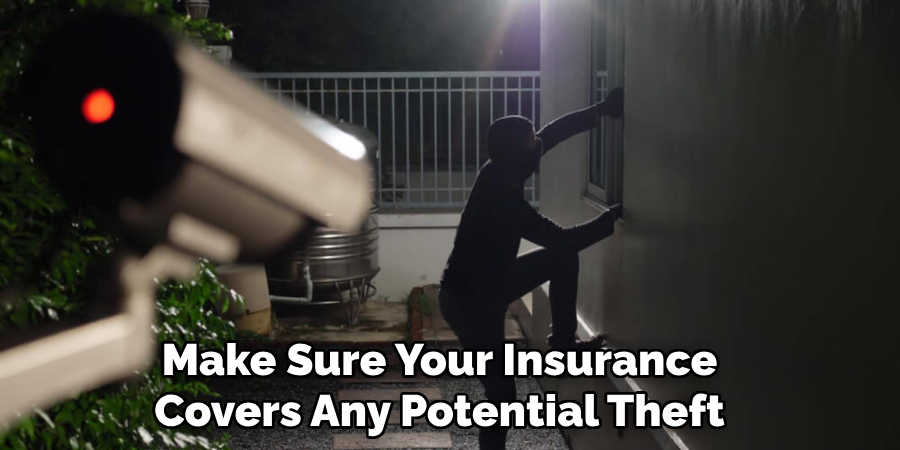
With these additional tips and tricks, you can further enhance the security of your outdoor furniture and deter potential thieves.
5 Things You Should Avoid
- Neglecting to Secure Lightweight Items: It’s essential to either secure or store lightweight items when not in use. Chairs, cushions, and decorative pieces can easily be carried off if not properly anchored or stowed away.
- Using Low-Quality Locks and Cables: Opting for cheaper, low-quality locks and cables can be a false economy. They are often easily cut or broken, offering little to no deterrent to thieves. Invest in high-grade, weatherproof locking mechanisms.
- Ignoring Lighting and Visibility: Avoid placing valuable outdoor furniture in secluded, dark areas of your garden or patio. Poorly lit areas provide cover for thieves. Instead, ensure that your outdoor space is well-lit and visible to deter potential thefts.
- Overlooking the Importance of Surveillance: It is a mistake to think that simple physical security measures are enough by themselves. Avoid disregarding the use of security cameras or motion sensor lights, which can add an extra layer of deterrence and provide evidence in the event of theft.
- Failing to Utilize Timers or Smart Devices: In today’s smart home era, not using timers or smart devices to control outdoor lighting and security systems can be a missed opportunity. These devices can create the illusion of presence, deterring thieves even when you’re not home.
By steering clear of these common pitfalls, you can significantly enhance the security of your outdoor furniture and make your garden a less attractive target for thieves.
Is Outdoor Furniture Okay in the Rain?
Most outdoor furniture is designed to withstand exposure to the elements, including rain. However, constant exposure can cause damage over time and decrease its longevity. To ensure your outdoor furniture stays in good condition, it’s recommended to cover or store it during heavy rain or extended periods of inclement weather.
If your outdoor furniture has cushions or other fabric components, it’s essential to bring them indoors during rain or cover them with waterproof covers. This will not only protect the fabric from potential damage but also ensure it is dry and comfortable to use when you want to enjoy your outdoor space again.
Overall, while most outdoor furniture can withstand rain, taking extra precautions such as covering or storing them during bad weather can help prolong their lifespan and keep them looking like new.
What is the Best Way to Store Outdoor Furniture?
The best way to store outdoor furniture depends on the type of furniture and your personal preference. Some common options for storing outdoor furniture include:
- Covering: Using waterproof covers specifically designed for outdoor furniture can protect them from weather damage while also keeping them clean.
- Storing Indoors: If you have space, storing your outdoor furniture indoors during periods of bad weather or in the offseason is the best way to keep them safe and prolong their lifespan.
- Using a Storage Shed: Investing in a sturdy, weather-resistant storage shed can provide a designated space for your outdoor furniture when not in use.
- Disassembling: Some outdoor furniture, such as tables and chairs, may be easily disassembled and stored in smaller pieces. This option works well for those with limited storage space.
Overall, the best way to store outdoor furniture is in a clean, dry, and protected area. This will help prevent damage and prolong its lifespan. Keep these storage options in mind when deciding how to protect your outdoor furniture during periods of non-use.
How to Waterproof Outdoor Wood Furniture?
Wood furniture is popular for outdoor spaces due to its natural and rustic aesthetic. However, exposure to rain and moisture can be prone to rotting, warping, or cracking over time. To protect your wooden outdoor furniture from these issues, waterproofing is crucial. Here are some steps you can take to waterproof your outdoor wood furniture:
- Clean the Furniture: Before waterproofing, make sure your furniture is clean and free of dirt, debris, and any previous coatings. Use soap and water or a wood cleaner to thoroughly clean the surface.
- Sand it Down: Sanding the wood will help remove any rough spots or imperfections on the surface, allowing for better absorption of the waterproofing product.
- Choose a Waterproofing Product: There are many options for waterproofing wood, including sealers, stains, and oils. Make sure to choose one that is specifically designed for outdoor use and compatible with your type of wood.
- Apply the Product: Follow the instructions on the chosen product and apply it evenly over the entire surface of your furniture using a brush or roller.
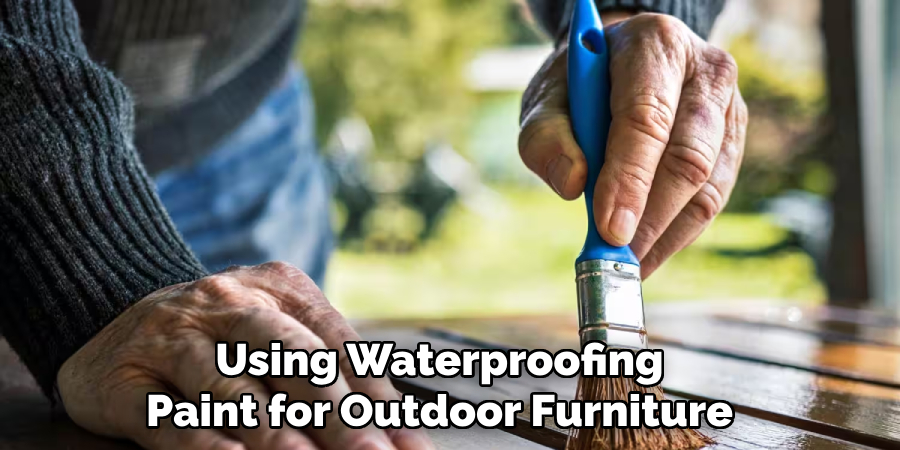
By taking these steps to waterproof your outdoor wood furniture, you can protect it from the damaging effects of rain and moisture and enjoy its beauty for years to come.
Conclusion
How to secure outdoor furniture from theft requires a comprehensive approach that blends practicality with technology. Homeowners can significantly reduce the risk of theft by addressing common vulnerabilities and employing strategies such as securing lightweight items, investing in high-quality locks and cables, enhancing visibility with adequate lighting, and leveraging surveillance technology.
The implementation of timers or smart devices further strengthens security measures by simulating occupancy. Ultimately, the goal is to create a layered defense that not only deters potential thieves but also protects your valuable outdoor assets, even in your absence.
Remember, the key to effective outdoor furniture security lies in anticipation and preparation, ensuring peace of mind and the enduring enjoyment of your outdoor spaces.
About
Safety Fic is a distinguished figure in the world of Diy design, with a decade of expertise creating innovative and sustainable Diy solutions. His professional focus lies in merging traditional craftsmanship with modern manufacturing techniques, fostering designs that are both practical and environmentally conscious. As the author of diy, Safety Fic delves into the art and science of Safety Fic-making, inspiring artisans and industry professionals alike.
Education RMIT University
(Melbourne, Australia) Associate Degree in Design (Safety Fic) Focus on sustainable design, industry-driven projects, and practical craftsmanship. Gained hands-on experience with traditional and digital manufacturing tools, such as CAD and CNC software.
Nottingham Trent University
(United Kingdom) Bachelor’s in diyfastly.com and Product Design (Honors) Specialized in product design with a focus on blending creativity with production techniques. Participated in industry projects, working with companies like John Lewis and Vitsoe to gain real-world insights.
Publications and Impact
In diy, Safety Fic his insights on indoor design processes, materials, and strategies for efficient production. His writing bridges the gap between artisan knowledge and modern industry needs, making it a must-read for both budding designers and seasoned professionals.
